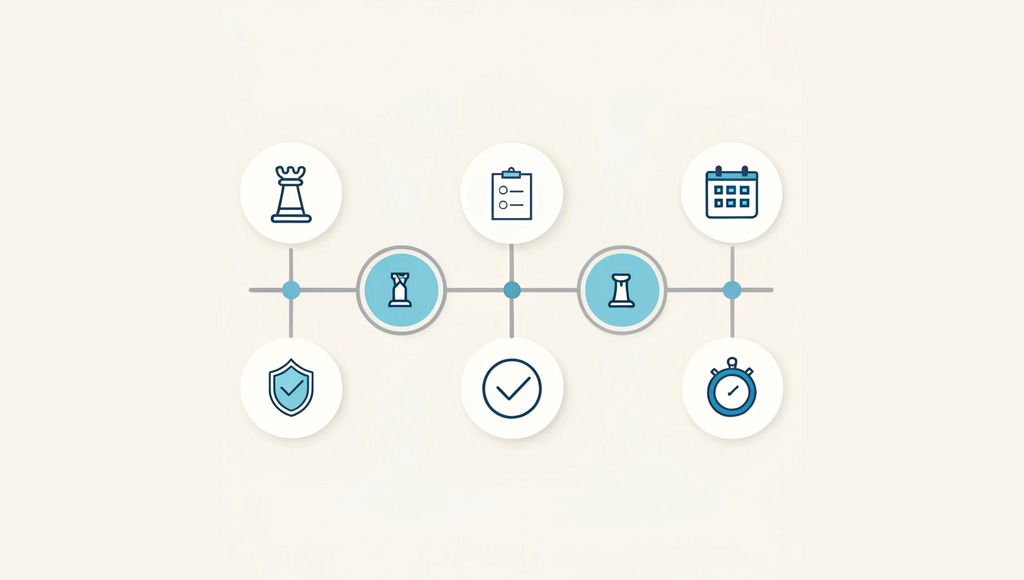
Selling your medical practice to a private equity firm is a significant undertaking. If you’re wondering how long the process takes, this guide provides a realistic, phase-by-phase breakdown of the healthcare M&A timeline, from initial preparation to the final closing.
A private equity transaction is a marathon, not a sprint. While some high-level overviews suggest a deal can be done in 3-6 months, our experience shows that a well-managed process for a mid-sized medical practice typically takes 7 to 15 months. Most often, the timeline falls within the 9 to 12-month range.
This detailed breakdown expands on the overview in our main Guide to PE in Healthcare: What Practice Owners Need to Know About Private Equity Partnerships to give you a clear picture of what to expect at every stage.
Phase 1: Preparation & Strategic Positioning (1–3 Months)
The most successful transactions begin long before any buyer is contacted. This foundational phase is about getting your house in order to maximize value and ensure a smooth process. Rushing this step is one of the most common mistakes sellers make.
Key activities during this phase include:
* Internal Alignment: All physician-owners must be on the same page regarding the decision to sell, their goals for the transaction, and their desired roles post-sale.
* Data Assembly: You will gather three to five years of financial statements, tax returns, payroll records, provider productivity reports, and key operational data.
* Financial Cleanup: This involves working with an advisor to normalize your financials. This process adjusts for owner-specific perks and non-recurring expenses to present a clear picture of the practice’s true earning power. For a deeper look at this crucial step, see our EBITDA Normalization Guide.
* Advisor Engagement: You will select your M&A advisory team, including an investment banker and legal counsel. This team will guide you through the entire process.
Proactively managing this phase can significantly shorten the rest of the timeline and strengthen your negotiating position.
Phase 2: Marketing & Interest Generation (2–3 Months)
With your preparations complete, your M&A advisor will take your practice to market. The goal is to create a competitive environment by approaching a curated list of qualified buyers.
Here’s what happens:
* Marketing Materials: Your advisor develops a “Teaser,” a one-page anonymous summary of your practice, and a detailed Confidential Information Memorandum (CIM). The CIM is a comprehensive document that tells the story of your business, its financial performance, and its growth opportunities.
* Buyer Outreach: The role of the investment banker is to confidentially contact a list of potential private equity and strategic buyers who are active in your specialty.
* Initial Bids: Interested buyers who have signed an NDA will review the CIM and submit a non-binding Indication of Interest (IOI). The IOI provides a preliminary valuation range and outlines the proposed structure of the deal.
Your advisory team will help you evaluate these initial offers to select a smaller group of serious buyers to advance to the next phase.
Phase 3: Due Diligence & Bidding (2–4 Months)
This is the most intensive phase of the entire transaction. The top-tier buyers you’ve selected will conduct a thorough investigation of every aspect of your practice to verify the information in the CIM and assess any potential risks.
Due diligence is a deep dive covering:
* Financial Diligence: Buyers will scrutinize your financial statements, quality of earnings, billing and coding practices, and payer contracts.
* Legal Diligence: A review of corporate documents, provider employment agreements, leases, and any pending litigation.
* Compliance Diligence: An audit of your adherence to HIPAA, Stark Law, and other healthcare regulations.
* Operational Diligence: An assessment of your clinical workflows, staffing models, and IT systems.
During this time, you and your management team will participate in presentations and host site visits for the prospective buyers. The process culminates with the receipt of final, more detailed offers in the form of a Letter of Intent (LOI). You can find a complete list of items to prepare in our PE Due Diligence Checklist for Practices.
Phase 4: Negotiation & Definitive Documentation (1–2 Months)
After you select a final buyer and execute the LOI, the attorneys take center stage. The LOI is largely non-binding, but now you will negotiate the definitive, legally binding agreements that will govern the sale.
This phase is focused on finalizing the key terms of the deal, including the final purchase price, working capital adjustments, earnout structures, and the specifics of physician employment and equity rollover. The extensive back-and-forth between legal teams is what makes this stage take time. Your legal counsel plays a critical role in protecting your interests and minimizing your post-closing liabilities.
Phase 5: Regulatory Approvals & Closing (1–3 Months)
With signed definitive agreements in hand, you’re in the home stretch. This final phase involves clearing any remaining hurdles before the transaction can officially close.
The key activities are:
* Regulatory Filings: Depending on the size and location of your practice, you may need to file for approval from federal antitrust authorities (Hart-Scott-Rodino Act) or state medical boards. These reviews can take anywhere from 30 days to several months.
* Final Confirmatory Diligence: The buyer will do a final check to ensure nothing has materially changed in the business since the diligence phase.
* Transition Planning: You will work with the buyer to map out the initial integration steps. This planning is essential for a smooth handover, as detailed in our guide to the First 100 Days After Acquisition.
Once all approvals are received and conditions are met, the deal closes. At closing, funds are transferred, and the partnership with your new PE partner officially begins.
Healthcare M&A Transaction Timeline at a Glance
| Stage Name | Typical Timeline | Key Activities |
|---|---|---|
| Preparation & Positioning | 1–3 months | Internal alignment, data assembly, advisor engagement, financial cleanup. |
| Marketing & Interest Generation | 2–3 months | CIM development, buyer outreach, receipt of Indications of Interest (IOIs). |
| Due Diligence & Bidding | 2–4 months | In-depth buyer diligence, management presentations, site visits, LOI selection. |
| Negotiation & Documentation | 1–2 months | Negotiation of definitive agreements, finalizing key deal terms. |
| Regulatory & Closing | 1–3 months | Regulatory approvals, final confirmatory diligence, closing and funding. |
| Total Estimated Timeline | 7–15 Months |
Why Timelines Vary: Key Factors That Shift the Schedule
No two transactions are identical. Several factors can influence whether your process lands on the shorter or longer end of the typical range:
* Your Preparedness: A practice with clean financials and organized data will move through diligence much faster.
* Deal Complexity: Transactions involving multiple legal entities, real estate, or complex partner arrangements naturally take longer.
- Regulatory Hurdles: Deals in states with stringent review processes or in highly consolidated specialties may face additional delays.
- Buyer Responsiveness: The speed and efficiency of the buyer’s team and their advisors can have a major impact on the pace.
- Market Conditions: Broader economic factors and competition among buyers can either accelerate or slow down processes.
A Marathon, Not a Sprint
Selling your medical practice is one of the most significant professional decisions you will ever make. The process is lengthy and demanding, but a structured approach guided by experienced advisors ensures you move forward with confidence and clarity. The best way to control your timeline is to invest in thorough preparation, which positions you to negotiate from a position of strength and navigate the complexities of a transaction efficiently.
If you are considering a sale and want to understand how this timeline applies to your unique practice, we can help. Learn more about how we guide physicians through successful exits by exploring our sell-side advisory services.
Frequently Asked Questions
How long does the entire process of selling a healthcare practice to a private equity firm usually take?
Selling a healthcare practice to a private equity firm typically takes between 7 to 15 months, with most transactions falling in the 9 to 12-month range. This timeline includes all phases from preparation to closing.
What is the very first step a practice owner should take when considering a sale to private equity?
The first step is preparation and strategic positioning, which lasts about 1 to 3 months. It involves getting internal alignment among owners, assembling necessary financial and operational data, performing financial cleanup (like EBITDA normalization), and engaging advisors such as investment bankers and legal counsel.
How long is the due diligence period in a private equity transaction for a healthcare practice, and what does it involve?
The due diligence phase typically lasts 2 to 4 months and is the most intensive part of the transaction. It includes detailed examination of the practice’s financials, legal documents, compliance with healthcare regulations, and operational workflows. During this time, management presentations and site visits occur, culminating in the submission of final bids through Letters of Intent (LOIs).
What happens after signing the Letter of Intent (LOI) in the healthcare private equity sale process?
After signing the LOI, the process moves into the negotiation and definitive documentation phase, lasting 1 to 2 months. This involves negotiating legally binding agreements, covering purchase price, earnouts, employment contracts, and other critical terms. Experienced legal counsel plays a key role in protecting the seller’s interests during this phase.
What factors can cause the timeline for selling a medical practice to a private equity firm to vary?
Several factors influence the timeline, including:
– The level of preparedness of the practice, such as clean financials and organized data.
– Complexity of the deal, including multiple entities or real estate involvement.
– Regulatory approvals required, which can vary by state and specialty.
– The responsiveness and motivation of the buyer’s team.
– Broader market and economic conditions that affect buyer competition and speed.



